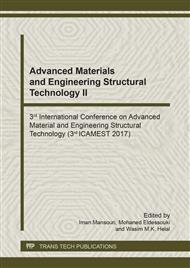p.90
p.95
p.100
p.106
p.112
p.117
p.123
p.129
p.134
Experimental Investigation on Physical and Mechanical Behavior of Kathmandu Clay
Abstract:
Deformation due to load from the construction of infrastructure in soft ground is high and sometimes also becomes problematic. There are various techniques to strengthen the ground among which, the most suitable and commonly used method is chemical stabilization using cement. This method is fast and cement is relatively cheap, abundant and efficient. This research is focused on the study of improvement on physical and mechanical properties of cement mixed clay. Soil sample from Kathmandu, Nepal is taken for the laboratory investigations. The soil is reconstituted by using Ordinary Portland Cement of 5%, 10%, and 15% by its mass. The study revealed that physical and mechanical characteristics of cemented clay are greatly improved for engineering purposes. The specific gravity of all samples are linearly vary with cement content. Similarly, the liquid limit and plastic limit of clay are increased with increased cement content. However, hydraulic conductivity of the soils is decreased with the increase in cement content i.e. reduction is almost 7.5 times when cement increases from 5% to 15%. Finally, cohesion is increased from 3.23 kPa to 67.89 kPa in contrast to friction component which is decreased from 19.58° to 18.56°. Therefore, shear strength of clay is improved due to improvement on cohesion property of clay because of the reduction in the thickness of the diffused doubled-layer of adsorbed water.
Info:
Periodical:
Pages:
112-116
Citation:
Online since:
March 2018
Authors:
Keywords:
Price:
Сopyright:
© 2018 Trans Tech Publications Ltd. All Rights Reserved
Share:
Citation:


